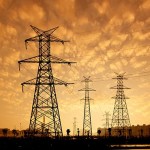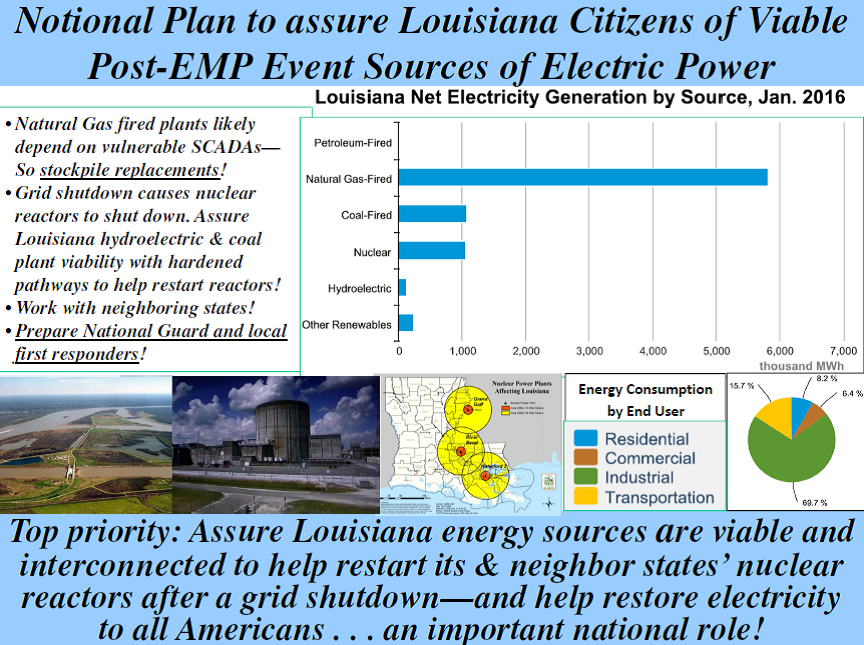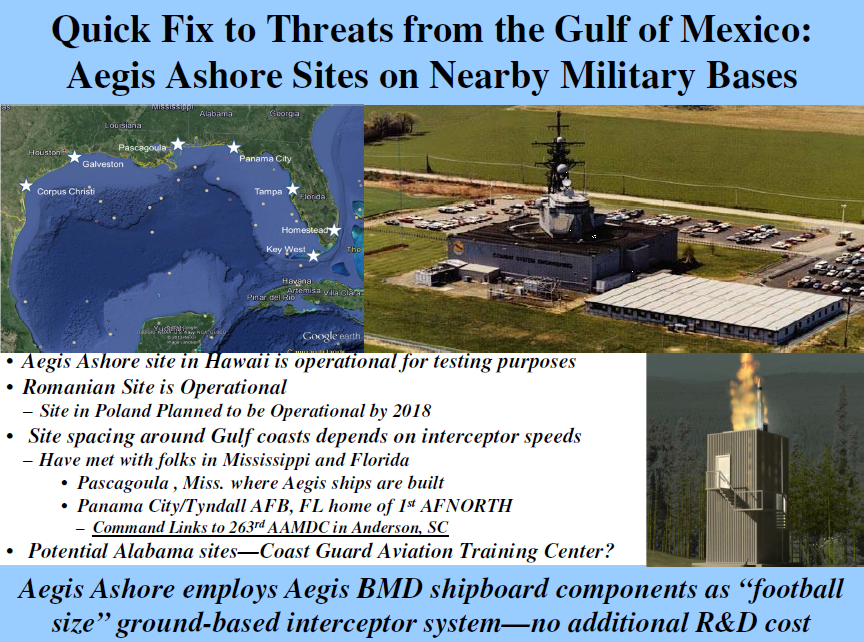Local and state initiatives are needed to protect all Americans from some existential threats to the electric power grid, because leaders in the Federal Government are failing at their duty to “provide for the common defense.” Happily, much can be accomplished by such initiatives, but protection against ballistic missiles launched from vessels in the Gulf of Mexico requires action by the Federal Government to protect the entire nation.
Over the past week or so, several conferences in Texas, Indiana, Louisiana, and Alabama were hosted by citizens concerned about existential threats to the electric power grid. Members of the Secure the Grid Coalition (from the Center for Security Policy, High Frontier, the EMP Task Force for National and Homeland Security, the EMP Special Interest Group (SIG) of InfraGard and several local organizations from these and other nearby states) briefed several hundred prospective activists interested in countering such existential threats at the local and state level.
I expect the videos from many if not all of these conferences will be posted on the Secure the Grid webpage (http://securethegrid.com/) — and will provide links from our High Frontier webpage as they become available.
My message last week, mentioned our Texas and Indiana conferences. This week, I’ll mention our conferences in Louisiana and Alabama. The response in all conferences was very encouraging.
Our collective discussion in all states emphasized that survival in case of the loss of the electric grid — as would be likely if competently attacked in its current vulnerable situation — would depend on state and particularly local preparations in advance.
These “First Responders” should be prepared to deal with attacks involving some combination of kinetic, cyber and electromagnetic pulse (EMP) technology that could be used by nation states or terrorists. And without much if any help from Washington.
Moreover, they should be prepared for the consequences of one of the regularly occurring major solar emissions that crosses the earth’s orbit at just the right time for its “natural” EMP to produce a major worldwide electric grid failure — only the timing of this certain-to-occur event is uncertain. Credible estimates suggest such an event has a 12-percent likelihood per decade. One is due, since the last such event occurred in 1859.
That “Carrington Event” caused fires and damage to telegraph communication systems — as well as the brand new undersea telegraph cable between the United States and Europe. But the impact on the then-agrarian society was minimal — today, the result would be catastrophic because of our dependency on electricity and solid state electronics, and the lack of sustaining life support from our “just in time” economic realities.
Click here for an early High Frontier (July 16, 2013) discussion of this important “natural EMP” threat to the electric grid, then recognized by public media as reported in the preceding Sunday’s Business Section of the Washington Post. An important problem identified — but still not effectively dealt with.
The High-altitude EMP (HEMP) that would result from a nuclear explosion high in, or above, the Earth’s atmosphere would include the same low-frequency phenomena over many seconds as caused by a major solar emission. And it would also include two higher frequency, much shorter pulse width, components:
- A midrange component is similar to lightning which should be countered by the usual surge arrestors.
- The other is a much higher frequency component — a nanoseconds wide electronic “shock” that would damage unprotected electronics, which are currently pervasive in the small computers that are essential to the viability of critical (and mostly unprotected) infrastructure throughout our society. We could and probably would (unless we change our ways in time) lose the benefits of many if not all of our current indigenous electronic dependencies on modern cellphones, I-pads and other means of communications; banking; transportation; oil and natural gas distribution systems; water and wastewater distribution; medical supplies; etc.
There are international efforts, including from the Obama administration, dealing however slowly with the “solar storm” threat — and that’s a good thing. But protection against such major solar events will not protect the electric grid from the midrange and high frequency components of a HEMP event.
When we wake up to that more damaging threat, we will have to do the job all over again. Why not address the HEMP threat first, which will also deal with the “solar storm” threat?
Hopefully the EMP Commission will help rectify this unfocused situation — if ever it is re-established by the Defense Department as directed in the National Defense Authorization Act of 2016, signed into law last November. Such bureaucratic lethargy illustrates that there is little Executive Branch leadership in Washington for dealing with these societal threats.
The EMP threat has been known since the 1960s, but it was highly classified for most of the period since then and only dealt with for a few very important military systems — to assure warning of Soviet nuclear-armed ballistic missile attacks and the President’s ability to respond in kind. While it remains a relatively unknown threat, it has been openly discussed for some time. For example, click here for a very informative 2011 conference at the Heritage Foundation that covered most of the issues we have covered in discussions over the past week or so.
In particular, I urge you to watch the keynote address by former Representative Roscoe Bartlett, who was instrumental in initiating the EMP Commission that reported out in 2004 and 2008 — the 2008 report is a particularly valuable source of information that had previously been highly classified.
Given the Federal Government’s lethargy, local and state initiatives are very important — and in that context, help from Washington will likely continue to be slow to say the least.
My focus in this week of conferences was to encourage state and local initiatives on two issues that are top priorities for High Frontier:
- Assuring that our Nuclear Power plants are viable in case of a major grid shutdown so that they do not become a radiation hazard (like occurred following the March 11, 2011 Fukushima event) and instead become a major resource in restoring the grid after a major “Blackout” of indefinite duration.
- Ending the nation’s vulnerability to ballistic missiles launched from vessels in the Gulf of Mexico — against which we currently have no defense. Aegis Ashore ballistic missile defense (BMD) systems could be located on military bases around the Gulf of Mexico — just like those being deployed in Europe to defend against Iranian ballistic missiles.
Last week’s message noted our excellent reception in Texas and Indiana, where local citizens and their state representatives are getting involved. Our reception in Louisiana and Alabama followed suit.
Click here for my briefing in Louisiana, where I anticipate significant future initiatives. Over a hundred members of the Governor’s Office of Homeland Security and Emergency Preparedness (GOHSEP) were very responsive, and Governor John Bel Edwards raised his personal concerns to that assembled group before our conference began, encouraging them to address this urgent problem. A few of us had a very encouraging subsequent discussion with him over dinner.
After serving as an Army Airborne Ranger following his graduation from West Point, the Governor said he was surprised that he never learned about the EMP issue until recently — and I told him that was because it had been highly classified until the EMP Commission’s 2008 report — and that many are still ignorant of the existential threat EMP poses to all Americans.
That ignorance is one of the two major reasons that this urgent problem is being ignored. The other is that the Washington bureaucracy that should be seeking to address it is so badly broken that no one is in charge.
The figure below summarizes some of the problems and potential advantages that define how Louisiana might proceed in protecting against the EMP threat.
Note most of Louisiana’s electricity comes from natural gas fired plants — which may confront major problems deriving from failures of the many Supervisory Control And Data Acquisition (SCADA) systems that are in the natural gas distribution and operating systems. These small computers are required to function well to supply a viable major portion of Louisiana’s energy needs — and unless hardened they probably will fail in major proportions.
As indicated in the above figure, Louisiana’s Commercial and Industrial sectors consume three-quarters of Louisiana’s electricity — and would no doubt suffer major losses from a loss of power from the natural gas plants. Louisiana needs to stockpile replacement SCADAs and be prepared to deal with the consequences of major failures in the distribution of electricity from these plants.
I emphasized that Louisiana should give top priority to assuring that some its coal-fired and hydroelectric plants (which are more resilient and easier to “harden” than other power plants) are viable and can supply power via hardened and tested transmission lines to its nuclear power plants after a major blackout so that they can become a major energy resource to help reinstate the grid in Louisiana and beyond. This constructive preparation will help minimize the prospects of Fukushima-like radiation hazards from unprotected nuclear reactor plants.
I made many of the same points in Alabama, which also depends on likely vulnerable natural gas distribution systems and gas fired power plants, though with a much greater percentage of its electricity from more resilient hydroelectric and coal power plants. Still, an Alabama SCADA stockpile and natural gas recovery plan would be prudent.
Because of Alabama’s Huntsville home for developing most of the nation’s BMD systems dedicated to our homeland defense, I emphasized the “powers that be” failure in protecting our nation from threats from the South, especially from the Gulf of Mexico.
See my chart below, which emphasizes that the Aegis Ashore system now operational in Romania and scheduled to be operational in Poland in 2018 could be built at several military bases around the Gulf of Mexico to protect all Americans against this existing threat. (The required number of bases depends on the BMD interceptor speed, which is increasing as additional interceptors are developed.)
It should be remembered that the first generation Standard Missile-3 was the interceptor of choice in 2008 for shooting down a dying U.S. satellite that presented a threat to Americans and others because of its onboard toxic fuel. Current versions are improved over that impressive capability and future versions will be even more improved. An inherent antisatellite capability should soon be available for countering Iranian and North Korean satellites carrying nuclear weapons over the South Polar regions, provided the appropriate forward based sensors provide effective cueing information.
Aegis Ashore is a Navy BMD system — and Huntsville has long focused on developing Army BMD systems. But when it comes to protecting the American homeland, parochial interests should be of no concern. Aegis BMD systems are already integrated into the Missile Defense Agency’s global sensor network, which needs improvement for more effective operations — but already has a significant capability.
The Aegis Ashore system is well designed, tested and operational to protect our allies and overseas troops from Iranian ballistic missiles, as noted above. It can be deployed on football field size areas on military bases around the Gulf of Mexico with the only considerations of concern being public safety and environmental impact.
Remember it was originally developed for our Aegis Destroyers and Cruisers, now operational with a crew of nearby sailors on about 35 ships deployed around the world. Since we were meeting in Mobile, I suggested that Alabama might consider an Aegis Ashore site at its Coast Guard Aviation Training Center, though a quick look suggests that location proximity may present public safety concerns.
Such a deployment deserves high priority, because it is a longtime well-recognized threat. As again reported last week, then Defense Secretary Don Rumsfeld in 2002 observed this fact—but neither he nor his lieutenants did anything about it. And the threat still exists, echoed by his 2002 words:
“Countries have placed ballistic missiles in ships – dime a dozen – all over the world. At any given time, there’s any number off our coasts – coming, going. On transporter-erector-launchers, they simply erect it, fire off a ballistic missile, put it down, cover it up. Their radar signature’s not any different than 50 others in close proximity.”
Defense Secretary Don Rumsfeld, Pentagon Press Briefing—September 16, 2002
Again, we know how to do this — no research and development is needed. We just need get on with defending the Americans as well as our European allies.
I get positive reactions from citizens when I point out the absurdity that we are so foolishly leaving them vulnerable to this threat as well as the threats to the electric grid. More accurately, I find they are upset that their elected officials are failing in their sworn duty to “provide for the common defense.”
We can do these things . . . the only question is, “Will we?”
For the good of my kids and grandkids, I hope so.
Get involved yourself, and stay tuned!!!
Bottom Lines.
Demand that your elected official straighten out this mess — beginning at the local level with the folks you know! Literally, your life is at stake!
State legislatures and the U.S. Congress should pass legislation to address the problems, and on behalf of the American People demand an end to this dysfunctionality and provide for the common defense.
Congress should also provide a more constructive regulatory arrangement of the electric power operations that deals effectively with the reality of the EMP threat, as well as other threats to the grid.
There are some signs of movement in the right direction — for example, with helpful language in the Energy Bill for Fiscal Year 2016. But we have a long way to go before the new Commander of Northern Command, soon to be sworn in, can report that part of her job will be to help protect the American People as part of the NORTHCOM mission. Incredible as absurd as it seems it is not part of her mission today.
Hopefully, the Defense Department will soon re-establish the EMP Commission, as directed by the National Defense Authorization Act of 2016, signed into law some five months ago.
These issues should be high priority items on their agenda. Not the least should be to help identify “Who’s in charge?” . . . or more importantly to recommend, “Who Should Be in Charge!”
Stay tuned!
Near-Term High Frontier Plans.
We will continue to inform our readers of the looming threats we confront — and where appropriate urge them to engage in countering those threats. We will press for building the most cost-effective ballistic missile defenses possible and working with South Carolina folks to build a coalition to engage constructively with private citizens and their local and state representatives and other authorities to work with the SC National Guard in understanding and responding to the existential threats to the electric power grid.
We are especially focused on the nuclear power reactors that produce 60-percent of SC electricity—and more generally 20-percent of the nation’s electricity. If it can be assured that they “operate through” a major blackout of the electric power grid — and I believe it can, then these reactors can play a very important role for resurrecting the grid over an extended time and supporting the general public’s survival in the meantime.
See the new figure recently added to the top of our webpage for an illustration of how wind patterns might carry far and wide any significant radiation from the nation’s reactors if we don’t get this right!
What can you do?
Join us in praying for our nation, and for a rebirth of the freedom sought, achieved and passed to us by those who came before us.
Help us to spread our message to the grass roots and to encourage all “powers that be” to provide for the common defense as they are sworn to do.
Begin by passing this message to your friends and suggest they visit our webpage www.highfrontier.org, for more information. Also, please encourage your sphere of influence to sign up for our weekly e-newsletter.
Encourage them to review our past email messages, posted on www.highfrontier.org, to learn about many details related to the existential manmade and natural EMP threats and how we can protect America against them. I hope you will help us with our urgently needed efforts, which I will be discussing in future messages.
Click here to make a tax deductible gift. If you prefer to mail a check, Please send it to 500 North Washington Street, Alexandria, VA 22314.
Please click here to read Past Weekly Updates!
Please help High Frontier continue this important and timely work!
Be sure to follow us on our Social Sites!
If you found this letter via our Social Sites, and you would like to subscribe, please click below!







